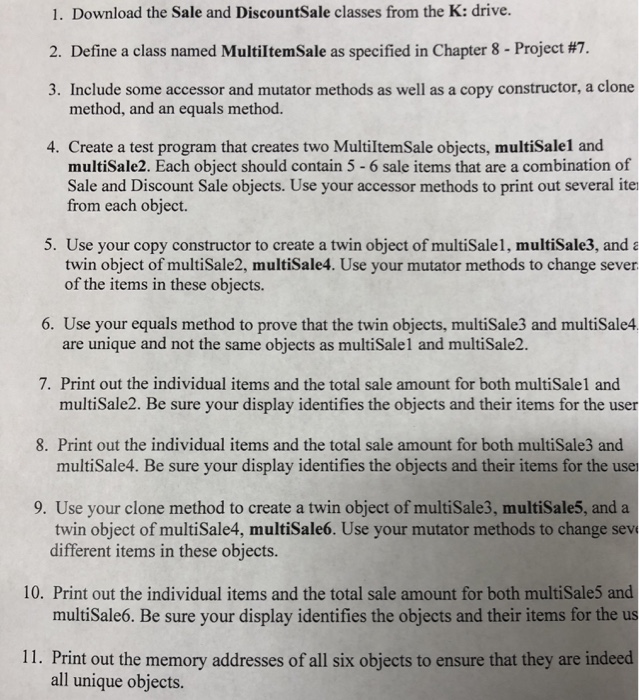Question
Java : /** Class for a simple sale of one item with no tax, discount, or other adjustments. Class invariant: The price is always nonnegative;
Java :
/**
Class for a simple sale of one item with no tax, discount, or other adjustments.
Class invariant: The price is always nonnegative; the name is a nonempty string.
*/
public class Sale
{
private String name; //A nonempty string
private double price; /onnegative
public Sale( )
{
name = "No name yet";
price = 0;
}
/**
Precondition: theName is a nonempty string; thePrice is nonnegative.
*/
public Sale(String theName, double thePrice)
{
setName(theName);
setPrice(thePrice);
}
public Sale(Sale originalObject)
{
if (originalObject == null)
{
System.out.println("Error: null Sale object.");
System.exit(0);
}
//else
name = originalObject.name;
price = originalObject.price;
}
public static void announcement( )
{
System.out.println("This is the Sale class.");
}
public double getPrice( )
{
return price;
}
/**
Precondition: newPrice is nonnegative.
*/
public void setPrice(double newPrice)
{
if (newPrice >= 0)
price = newPrice;
else
{
System.out.println("Error: Negative price.");
System.exit(0);
}
}
public String getName( )
{
return name;
}
/**
Precondition: newName is a nonempty string.
*/
public void setName(String newName)
{
if (newName != null && newName != "")
name = newName;
else
{
System.out.println("Error: Improper name value.");
System.exit(0);
}
}
public String toString( )
{
return (name + " Price and total cost = $" + price);
}
public double bill( )
{
return price;
}
/*
Returns true if the names are the same and the bill for the calling
object is equal to the bill for otherSale; otherwise returns false.
Also returns false if otherObject is null.
*/
public boolean equalDeals(Sale otherSale)
{
if (otherSale == null)
return false;
else
return (name.equals(otherSale.name)
&& bill( ) == otherSale.bill( ));
}
/*
Returns true if the bill for the calling object is less
than the bill for otherSale; otherwise returns false.
*/
public boolean lessThan (Sale otherSale)
{
if (otherSale == null)
{
System.out.println("Error: null Sale object.");
System.exit(0);
}
//else
return (bill( )
}
public boolean equals(Object otherObject)
{
if (otherObject == null)
return false;
else if (getClass( ) != otherObject.getClass( ))
return false;
else
{
Sale otherSale = (Sale)otherObject;
return (name.equals(otherSale.name)
&& (price == otherSale.price));
}
}
public Sale clone( )
{
return new Sale(this );
}
}
/**
Class for a sale of one item with discount expressed as a percent of the price,
but no other adjustments.
Class invariant: The price is always nonnegative; the name is a
nonempty string; the discount is always nonnegative.
*/
public class DiscountSale extends Sale
{
private double discount; //A percent of the price. Cannot be negative.
public DiscountSale( )
{
super( );
discount = 0;
}
/**
Precondition: theName is a nonempty string; thePrice is nonnegative;
theDiscount is expressed as a percent of the price and is nonnegative.
*/
public DiscountSale(String theName,
double thePrice, double theDiscount)
{
super(theName, thePrice);
setDiscount(theDiscount);
}
// Copy Constructor
public DiscountSale(DiscountSale originalObject)
{
super(originalObject);
discount = originalObject.discount;
}
public static void announcement( )
{
System.out.println("This is the DiscountSale class.");
}
public double bill( )
{
double fraction = discount/100;
return (1 - fraction)*getPrice( );
}
public double getDiscount( )
{
return discount;
}
/**
Precondition: Discount is nonnegative.
*/
public void setDiscount(double newDiscount)
{
if (newDiscount >= 0)
discount = newDiscount;
else
{
System.out.println("Error: Negative discount.");
System.exit(0);
}
}
public String toString( )
{
return (getName( ) + " Price = $" + getPrice( )
+ " Discount = " + discount + "% "
+ " Total cost = $" + bill( ));
}
public boolean equals(Object otherObject)
{
if (otherObject == null)
return false;
else if (getClass( ) != otherObject.getClass( ))
return false;
else
{
DiscountSale otherDiscountSale =
(DiscountSale)otherObject;
return (super.equals(otherDiscountSale)
&& discount == otherDiscountSale.discount);
}
}
public DiscountSale clone( )
{
return new DiscountSale(this );
}
}

Step by Step Solution
There are 3 Steps involved in it
Step: 1

Get Instant Access to Expert-Tailored Solutions
See step-by-step solutions with expert insights and AI powered tools for academic success
Step: 2

Step: 3

Ace Your Homework with AI
Get the answers you need in no time with our AI-driven, step-by-step assistance
Get Started


